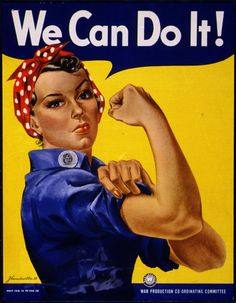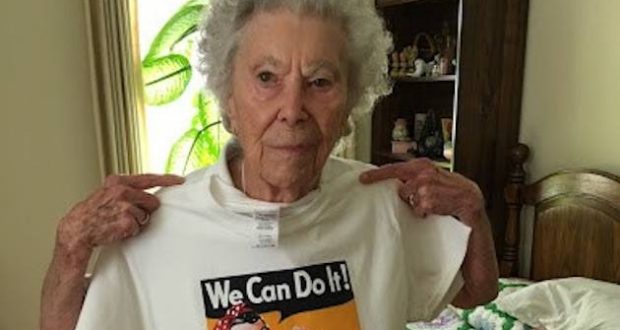We’ve all seen images of Rosie the Riveter, the strong woman who went to work during World War II with the slogan, “We can do it.”
One of the last Rosies, 93-year-old Vera Davis, lives in south Kansas City. She was a riveter, and worked on on B-25 bomber planes at the Fairfax Plant in Kansas City, Kansas.
The plant is now home to General Motors but all those years ago, it was filled with women like Davis helping the war effort. Davis worked in the wing section, and started her job with North American Aviation on August 8, 1943.
 “I was a riveter,” Vera Davis said. “In fact I could do anything. Drill the holes or put the rivets in or buck the rivets. At that time we worked on tables. We had big long tables about ten feet long so we could reach the wings as they came through. I could do anything, any size. It didn’t make any difference.”
“I was a riveter,” Vera Davis said. “In fact I could do anything. Drill the holes or put the rivets in or buck the rivets. At that time we worked on tables. We had big long tables about ten feet long so we could reach the wings as they came through. I could do anything, any size. It didn’t make any difference.”
Every weekday morning for about two years, Davis would get up early, put on her matching blouse and scarf, and catch three different street cars to the plant.
It was a different world for a young woman raised on a north Missouri farm.
“At home, my job was milking cows,” Davis said. “Before school and after school.”
Davis says the job wasn’t hard. But the challenges of living through World War II were difficult.
“It was hard, Davis said. “Everything was rationed. You could only get so much meat, so much sugar.”
Today, Davis has countless Rosie the Riveter memorabilia.
“I had a puzzle of Rosie the riveter,” Davis said. T”hat I put together one winter. And it was exactly like that picture.”
But during World War II, the character commonly known as “Rosie the Riveter” didn’t really exist. Davis didn’t know about her. The poster depicting the now popular image was only used internally at Westinghouse for a couple weeks in 1943. The image resurfaced in the early 1980s, and that’s when she gained the name, and Davis’s attention.
“Like she’s showing her muscles, which I don’t have anymore,” Davis laughed. “I used to have muscles but I don’t anymore. Her hard work on the line was what built Davis’s strong arms.”
At first, only white men aged 18 to 35 could get jobs building the B-25s Davis worked on in KCK. As more and more men went to fight overseas, they opened aircraft jobs up to women, men of older and younger ages, and some minorities.
By fall of 1943, more than 9,000 women worked in the plant making B-25s, about 40 percent of employees. The B-25 double engine bombers are best known for their use by Lt. Col. James H. Doolittle in his raid on Tokyo in April of 1942.
“It was launched off aircraft carrier, which had never been done before,” Dan Stratman, a Retired Pilot, author and Air Force veteran said.
Stratman said the B-25s were the workhorse planes of World War II, that sent a strong message, especially during the infamous raid. There were more than 9,800 B-25s made during world war two. Almost 70 percent of them were made at the Fairfax plant.
“We proved that allied air forces could reach the homeland of Japan, which hadn’t been done before,” Stratman said. “So that gave us a propaganda victory, it boosted morale and it showed the Japanese military that they weren’t safe in their homeland of Japan. That they could be struck. So it changed the mindset of both sides of the conflict in the Pacific.”
Davis and other women who held jobs like her made a huge impact in the war effort.
“It was the first time they were really allowed in a lot of cases to work in jobs that men had and without them we wouldn’t have won the war,” Stratman said.
But Davis is modest about her contributions. She doesn’t really think about her days as a riveter much. Ask her, and she’ll tell you, she simply enjoyed supporting the cause.
“It just had to be done and we knew it had to be done,” David said. “We had to win that war or else. It was a trying time and a different time for me and probably everyone else.”
Davis worked as a riveter until the war was over. She celebrated the end of the war at Union Station.
–Fox4 TV
 Metro Voice News Celebrating Faith, Family & Community
Metro Voice News Celebrating Faith, Family & Community









